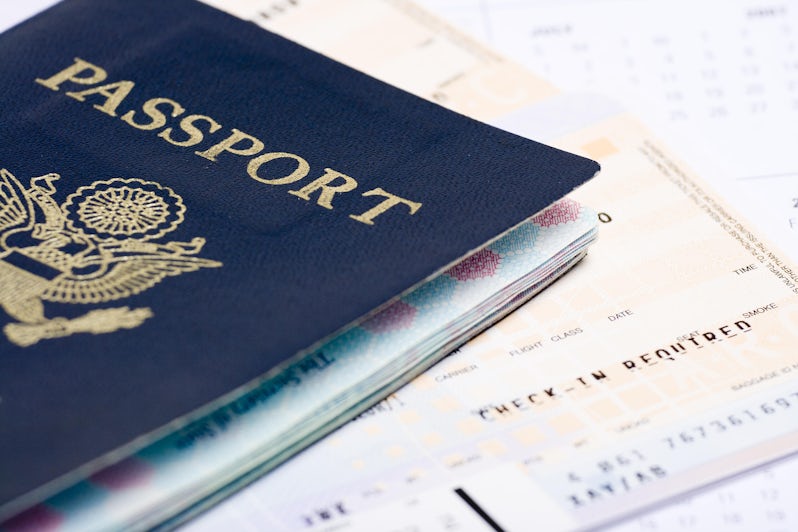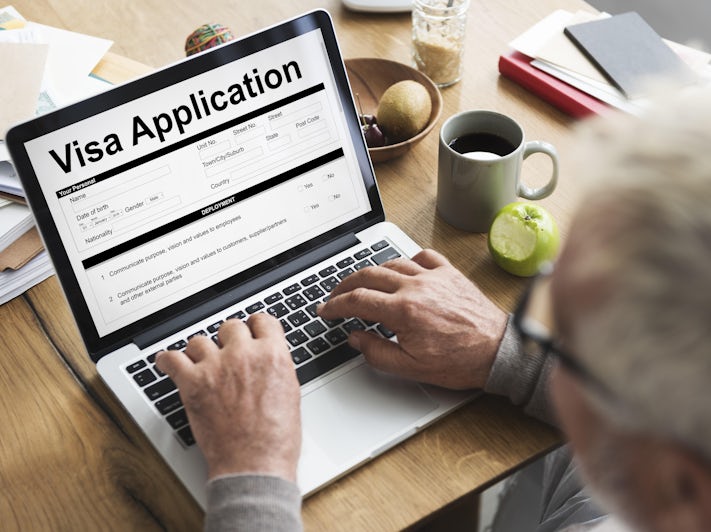
Cruise Rules and Regulations, Plus Travel Documents and Information


Your cruise line or travel agent can alert you to some of the cruise rules, regulations and restrictions that you need to know about for your next vacation at sea, but you can't count on them to tell you everything. It's best to educate yourself on the latest travel guidelines, including any travel documents required, before your next sailing -- especially as getting things wrong can lead to more travel hassles, extra expenses and possibly being denied boarding at the pier.
At best, the overview provided here is a snapshot. You'll want to double-check the current guidelines (with a site like travel.state.gov for U.S. citizens) as they pertain to your specific travel plans. To that end, we've provided you with your very own toolbox of internet resources, in addition to our general overview.
On This Page
What Documents Do I Need for a Cruise?
Passports
For U.S. citizens, passports are necessary for travel by land, sea or air anywhere outside the United States. American citizens may opt instead to use a U.S. Passport Card when traveling by land or sea (not air) between the United States and Canada, Mexico, Bermuda or the Caribbean. Approved by the U.S. Department of State, the card is a limited-use passport reduced down to the size of a driver's license. Most cruise lines require that the passport or passport card be valid for at least six months following the completion of your travels.
One exception to the passport or passport card rule applies to "closed-loop" cruises -- itineraries that begin and end at the same U.S. port. Passengers on these cruises still need to present a government-issued photo ID (such as a driver's license) and proof of citizenship (like a government-issued birth certificate), but they are not required to carry passports. Note that for kids younger than 16 years of age, a birth certificate (or its equivalent) alone will suffice.
However, we recommend passports even for closed-loop sailings because in the case of an emergency -- such as an injury or illness that forces you to debark early in a foreign port -- a passport will make it much easier to handle unexpected return travel by air. Also, some ports, like Martinique and Guadeloupe, will not allow you to enter the country without a passport, even on a closed-loop cruise.
Passengers without acceptable identification will not be allowed onboard and will not receive a refund if they miss the cruise for lack of correct documentation.
For more information, check out our sister website SmarterTravel.com's Passport Center.

Visas
For Americans, some popular cruise destinations, such as Russia and Australia, require visas. Check with your cruise line because individual country policies can vary. For instance, in Russia, if you plan to purchase a ship's shore excursion, the visa requirement is waived. If you choose to tour with a government-approved independent tour operator, you may also bypass the visa restriction. But if you plan to wander around ashore on your own, you'll have to secure a visa ahead of time.
Other countries, like Egypt and Turkey, will allow cruise ships to acquire "blanket visas" or visa waivers that cover all passengers for short visits of up to 72 hours. In this case, you typically won't have to do a thing (but do check with your cruise line beforehand, just in case).
For more information or to apply for a visa, contact the appropriate consulate or embassy near you; visas can also be obtained through third-party visa service companies, but you will pay an extra processing fee for the convenience.
Bottom line: The visa requirement is your responsibility, not the cruise line's. Double-check any information given to you by the cruise line regarding visas, and if you think you might need to apply for one, make sure you start the process well in advance of your trip.
Proof of Vaccination
Generally, vaccinations are not required for travel to cruise destinations, though many countries do list vaccine recommendations for travelers. (Taking medications to prevent malaria transmission in affected areas is a commonplace suggestion, for instance.) The main, albeit rare, exception is for yellow fever inoculations. If you are traveling to or have recently visited one of the 47 African countries or 13 South or Central American nations where there is a risk of yellow fever, you might be required to present proof of vaccination to enter ports in several countries like the Bahamas, Belize, Cambodia, China, Egypt, Mexico and more.
Cruise Boarding Documents
In order to board the ship, you'll need to show up at the embarkation terminal with your cruise boarding documents and personal identification in hand. The required boarding documents can typically be printed out at home ahead of time; some lines will still send them out via old-fashioned snail mail.
There will also be a credit card authorization form to set up your cashless onboard account, as well as a health questionnaire to assess your current state of health. (This is a safeguard against norovirus and other illnesses that could potentially be spread onboard.) Today, due to increased security requirements, many cruise lines require you to fill out the required documentation via online check-in ahead of your arrival at the cruise terminal; this step also helps to expedite lines at the pier.
In some ports (including Nassau), you might need a valid ID in addition to your cruise card to re-board your ship. Check requirements before disembarking.
Family Documentation
On some cruise lines or on certain itineraries, a single parent traveling with children might be required to show a letter of permission from the second parent. If parent and child don't share a last name, many lines require additional documentation (like the child's passport and birth certificate) as proof of the relationship. Grandparents or other guardians traveling with minors without either of their parents will also need a letter of consent from a parent and often an official form from the cruise line. Note that further documentation could be required for boarding an airplane for international flights; you can check in with the U.S. Department of State to verify what documentation is needed by country.
Also, if you plan to cruise while pregnant, many cruise lines require written approval from a doctor. See our mini-guide to cruising while pregnant for more.
Useful websites:
Cruise Rules, Regulations and Restrictions
Passenger Limitations
Most cruise lines will not allow women to sail in the third trimester of pregnancy; you must typically be 24 weeks pregnant or less on the day of disembarkation in order to cruise.
Babies must typically be at least 12 months old for trans-ocean, "exotic" or world cruises and 6 months old for all other cruise destinations (with some exceptions). Some adult-oriented ships don't allow children at all.
Note that on most cruise lines, passengers must be at least 18 or 21 years of age in order to travel on their own, without the accompaniment of a parent or guardian. Read up on such age restrictions in our Cruise Line Age Policies.
Department of Homeland Security (DHS) Requirements and Customs Clearance
The DHS requires cruise lines to provide a final passenger manifest at least an hour before departure. The deadline is one reason why cruise lines have encouraged passengers to provide their personal information well in advance of sailing via online check-in.
DHS also manages the U.S. Customs and Border Protection agency, in charge of processing passengers as they disembark the ship back in the U.S. For clearance, you'll be required to fill out a customs form and present your passport to immigration officials, either on the ship or in the cruise terminal. Be sure to hold on to receipts in order to declare goods purchased aboard, and to adhere to allowances for purchases of popular items like alcohol, cigarettes and cigars.
U.S. citizens and permanent residents looking for a shortcut on the customs line can apply for the Global Entry card ahead of their sailing, which allows for expedited customs clearance via an automated kiosk; at press time, however, note that Port Everglades in Fort Lauderdale is the only cruise port equipped to accept Global Entry passengers. Also at Port Everglades, cruisers can opt to speed up their entry through customs by downloading the free official Mobile Passport app, which allows them access to a specially designated (and often short) passport control line.
Note that local custom and immigration officials in other countries have their own clearance procedures in place for debarkation, which can vary based on the port of call and the nationality of disembarking passengers; your cruise line will provide related instructions for local protocol and practices aboard the ship, ahead of arrival.
Deposit and Booking Requirements
Note that cruises can typically be booked as far as 18 months in advance to as little as a week ahead of the scheduled sailing date. Lines do not require that you pay in full when booking. Rather, an initial deposit is required, which typically ranges in the amount of $250 to $1,000. The balance must usually be paid one to three months in advance of the sailing. Deposits are normally fully refundable if you cancel your sailing before the final payment is due. Likewise, advance cruise payments can usually be fully or partially refunded (sometimes minus a service fee) if the trip is canceled well in advance of the sail date. (Precise time frames vary by cruise line.)
For more, see What to Expect on a Cruise: Booking a Cruise and Cruise Line Cancellation Policies: A Closer Look.
Luggage Restrictions and Dress Codes
Note that, although there are no strict rules on the amount of luggage passengers can bring onboard a cruise, most line recommend no more than two checked bags per person. Cruise lines also have restrictions on items that passengers can bring on the ship with them, like travel irons and alcohol. (See What Not to Pack: 5 Things You Want to Bring on a Cruise -- But Shouldn't.) Also keep in mind that certain cruise lines have dress codes: See our Cruise Line Dress Codes story for more insight on just what to pack in the clothing department, by cruise line.

Smoking Policies
Cruise lines limit the areas in which passengers can smoke cigarettes, with even fewer locations where you can smoke a pipe or cigar. Nearly every cruise ship prohibits smoking in cabins -- including balconies -- and in restaurants. Smoking areas are restricted to select areas of outer decks and possibly one side of a nightclub or lounge or the casino. (See our story on Cruise Line Smoking Policies.)
Safety Drills
All passengers are required to attend on onboard safety drill, also known as the muster drill. As part of the drill, attendance is taken at muster stations, and crew members check all cabins to make sure passengers aren't hiding in their rooms. Failure to show up at the drill can result in penalties, including disembarkation from the ship.
Useful websites:
Air Travel Information for Your Cruise
Be forewarned: Airline regulations vary wildly. Here we're offering a sampling, culled from American and Delta. (If you're flying with another airline, check for their own specifics.) For more information, check out SmarterTravel.com's What to Expect at the Airport article.
Checking In
The recommended time to arrive at the airport is currently 90 minutes to two hours before departure for domestic and three hours before departure for most international flights. (Baggage check-in cutoff times depend on the airport and whether you're traveling in the U.S. or internationally.) While the airlines officially state that a passenger (with baggage to check) must have checked in at least 30 to 60 minutes in advance of flight time for a domestic flight, you might want to allow for more time, especially during busy holiday seasons.
Just remember: Requirements can change at a moment's notice. If you are returning to the States from any foreign destination, check with your airline for its current requirements; international airports and airlines often have different rules and procedures for check-in.
Carry-On Restrictions
In accordance with TSA (the agency responsible for airport security) regulations, all liquids, gels, aerosols, creams and pastes being carried on must be in 3.4-ounce or smaller containers, and they must be packed in a single one-quart-sized clear, re-sealable plastic bag. Exceptions include liquid medicines and baby food/milk. For more information, read the Airport Security Q&A from SmarterTravel.com.
Other rules: Most U.S. airlines limit carry-ons to one, plus one personal item. Personal items include computer and camera bags, purses, briefcases and other small bags that can fit under the seat in front of you. Items including crutches, canes, wheelchairs, walkers, purchased food (for onboard consumption) and outer garments are exempt. Many airlines also do not count items for lap infants, such as umbrella strollers or safety seats; check with your airline for its specific regulations. (Strollers and car seats can often be gate-checked free of charge.)
Anticipate a size restriction for your main carry-on. Maximum linear size (length + width + height) for the carry-on will vary by airline, but it's generally about 45 inches. International flights and carriers may have different (often more restrictive) carry-on rules than domestic ones; first and business classes often have different restrictions than coach. Be sure to check with your airline regarding your specific situation.

Checked Luggage
Most airlines charge you to check bags. For domestic travel, Delta, American and several other U.S. carriers charge economy class passengers $25 for the first checked bag and $35 for the second bag. Baggage to some international destinations is free, while other locales carry a surcharge. (Checked bags are free for business-class and first-class travelers, holders of certain airline-sponsored credit cards and elite-level frequent flyers.) Average weight maximums are 50 pounds; otherwise, plan to pay a surcharge. Child equipment (strollers, car seats) and wheelchairs can usually be checked free of charge.
Again, check with your airline for its specific luggage policies. Some airlines like Southwest don't charge bag fees at all or allow at least the first checked bag free. International travel will have different requirements than domestic.
Packing Restrictions
There are certain items that cannot be packed in your checked luggage. The list, which is too long to print here, changes periodically, so it makes sense to check with the TSA ahead of your trip.
Useful websites: